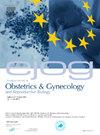对症状性脑卒中的最优治疗:一项深入的荟萃分析。
IF 2.1
4区 医学
Q2 OBSTETRICS & GYNECOLOGY
European journal of obstetrics, gynecology, and reproductive biology
Pub Date : 2025-02-01
DOI:10.1016/j.ejogrb.2024.12.048
引用次数: 0
摘要
背景:子宫腺肌症是一种常见的妇科疾病,是痛经的主要诱因,严重降低患者的生活质量。Dienogest已经成为一种很有前途的治疗bbb的药物。最近发表了一些关于这一主题的系统综述和荟萃分析。然而,这些荟萃分析通常基于2-7项研究,尽管可以提取数字数据,并且已经发表了更多的研究。此外,目前尚不清楚是否有任何患者的特征与治疗后更明显的改善有关,或者哪个患者亚组(如果有的话)将从最有效的治疗中获益最多。目的:评估dienogest在缓解子宫腺肌症相关痛经方面的疗效,并确定有助于更好治疗反应的研究/患者特征。设计:对近期发表的研究进行深入的荟萃分析。方法:采用痛经严重程度视觉模拟量表(VAS)评分作为主要结局指标,对截至2024年3月发表的14项研究进行深入meta分析,涉及637例患者。采用亚组分析和多变量回归分析探讨影响治疗效果的潜在因素。结果:Dienogest显著改善痛经,VAS评分(10分制)平均降低6分。亚组分析表明,dienogest对不同程度的痛经和不同的治疗时间都有效。值得注意的是,基线VAS评分较高和治疗持续时间较长的患者VAS评分下降幅度较大。结论:Dienogest可显著缓解子宫腺肌症患者的痛经,特别是那些基线痛经严重且治疗期延长的患者。然而,患者反应的可变性和潜在的不良反应强调了个体化治疗策略的重要性。需要进一步开展大规模、长期的比较研究和随机临床试验,以优化治疗效果,更好地了解患者特异性因素。本文章由计算机程序翻译,如有差异,请以英文原文为准。
Dienogest treatment of symptomatic adenomyosis: An in-depth meta-analysis
Background
Adenomyosis is a common gynecological disease and a major contributor to dysmenorrhea that substantially reduces the quality of life of the affected. Dienogest has emerged as a promising drug for treating adenomyosis. A few systematic reviews and meta-analyses on this topic have been published recently. However, these meta-analyses were typically based on 2–7 studies, even though numerical data could have been extracted and more studies have been published. Moreover, it is unclear whether there is any characteristic of the patients that is associated with more pronounced improvement after treatment, or which patient subgroup, if any, would benefit most from the dienogest treatment.
Objectives
To evaluate the efficacy of dienogest in alleviating dysmenorrhea associated with adenomyosis and identifying study/patient characteristics that contribute to a better therapeutic response.
Design
An in-depth meta-analysis incorporating more recent published studies.
Methods
An in-depth meta-analysis of 14 studies published up to March 2024, involving 637 patients was conducted, using the visual analog scale (VAS) scores on dysmenorrhea severity as the primary outcome measure. Subgroup analyses and multivariable regression were performed to explore potential factors influencing the treatment effect.
Results
Dienogest significantly improved dysmenorrhea, with a mean reduction in VAS scores of 6 on a 10-point scale. Subgroup analyses indicated that dienogest was effective across varying severities of dysmenorrhea and different treatment durations. Notably, patients with higher baseline VAS scores and longer treatment durations experienced greater reductions in VAS scores.
Conclusion
Dienogest substantially alleviates dysmenorrhea in women with adenomyosis, particularly among those with severe baseline dysmenorrhea and extended treatment periods. However, variability in patient responses and the potential for adverse effects underscores the importance of individualized treatment strategies. Further large-scale, long-term comparative studies and randomized clinical trials are warranted to optimize treatment outcomes and better understand patient-specific factors.
求助全文
通过发布文献求助,成功后即可免费获取论文全文。
去求助
来源期刊
CiteScore
4.60
自引率
3.80%
发文量
898
审稿时长
8.3 weeks
期刊介绍:
The European Journal of Obstetrics & Gynecology and Reproductive Biology is the leading general clinical journal covering the continent. It publishes peer reviewed original research articles, as well as a wide range of news, book reviews, biographical, historical and educational articles and a lively correspondence section. Fields covered include obstetrics, prenatal diagnosis, maternal-fetal medicine, perinatology, general gynecology, gynecologic oncology, uro-gynecology, reproductive medicine, infertility, reproductive endocrinology, sexual medicine and reproductive ethics. The European Journal of Obstetrics & Gynecology and Reproductive Biology provides a forum for scientific and clinical professional communication in obstetrics and gynecology throughout Europe and the world.

 求助内容:
求助内容: 应助结果提醒方式:
应助结果提醒方式:


